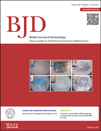-
Views
-
Cite
Cite
D. Pomponi, G. Di Zenzo, D. Zennaro, V. Calabresi, R. Eming, S. Zuzzi, M.L. Bernardi, E. Scala, A. Mari, Detection of IgG and IgE reactivity to BP180 using the ISAC® microarray system, British Journal of Dermatology, Volume 168, Issue 6, 1 June 2013, Pages 1205–1214, https://doi.org/10.1111/bjd.12161
Close - Share Icon Share
Summary
Background Bullous pemphigoid (BP) is an autoimmune skin disease in which patient autoantibodies react with BP180 and BP230 proteins. In addition to IgG, IgE has been shown to play a role in the disease.
Objectives To evaluate the feasibility of detecting IgE and IgG against the immunodominant BP180 NC16A domain (BP180) using a microarray system.
Methods BP180 was immobilized on an experimental version of the ISAC® microarray (Exp96). The BP study group and the controls were all tested on the commercial ISAC 103 version and on the Exp96. IgG and IgE were measured in a single run. BP180 IgG and IgE results were compared with those using an enzyme‐linked immunosorbent assay (ELISA).
Results All results obtained using the IgG ELISA on the 31 patients with BP were replicated with the ISAC IgG. Five of eight BP sera tested by ELISA showed similar results with ISAC IgE. Twenty‐nine (94%) and 19 (61%) of the 31 patients with BP were IgG and IgE positive to BP180, respectively, whereas four (3%) and six (4%) of 138 normal donors were IgG and IgE positive, respectively. Interestingly, the levels of IgG against BP180 detected using the ISAC system were related to the disease severity. Patients with BP showed a peculiar profile of IgE recognition toward some groups of allergens, which was absent in a group of allergic individuals. A significant, higher prevalence of hen’s egg recognition was observed in patients with BP who had specific IgE to BP180.
Conclusions The present preliminary study indicates that the ISAC microarray system is suitable for detecting IgG and IgE autoantibodies in patients with BP. Notably, this system allows the assessment of IgE and IgG autoantibodies at the same time, could be employed for the detection of autoantibodies to other autoantigens, and allows profiling for specific IgE to allergens.





